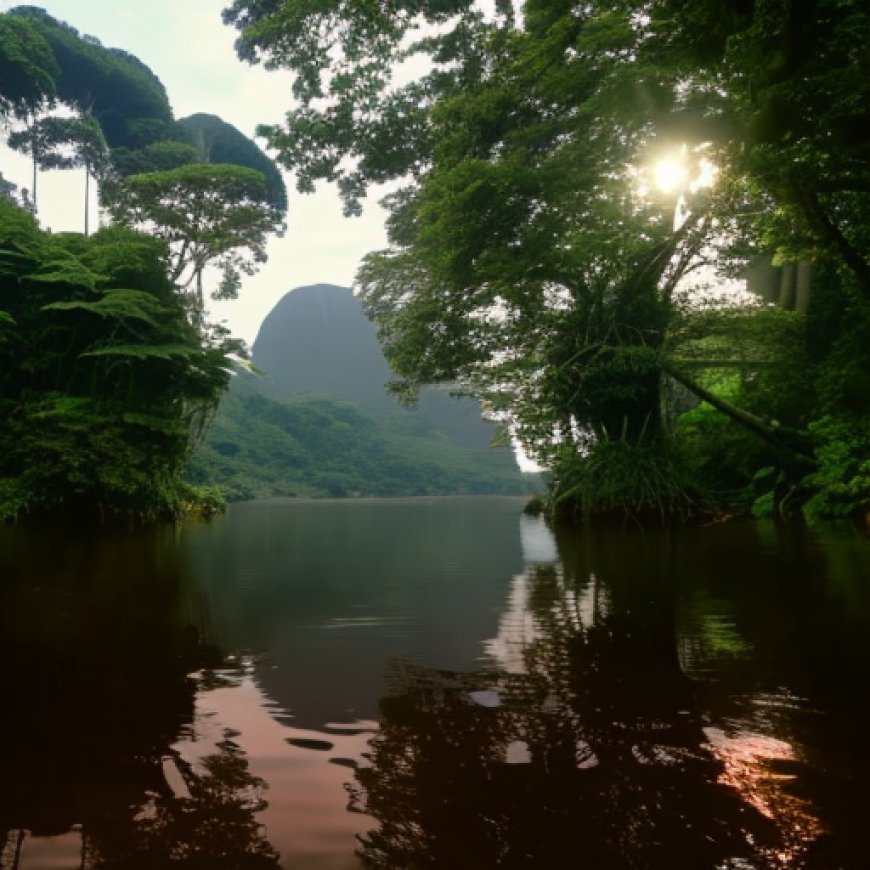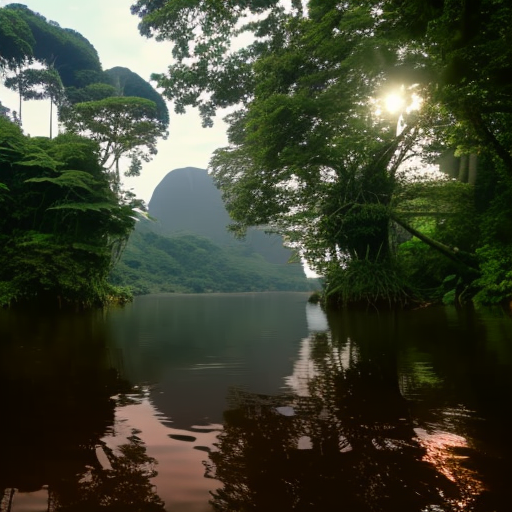As a megaport rises in Cameroon, a delicate coastal ecosystem ebbs
As a megaport rises in Cameroon, a delicate coastal ecosystem ebbs Mongabay.com


The Impact of the Kribi Deepwater Port on the Coastal Ecosystem in Cameroon
- The deepwater port at Kribi, Cameroon, is a massive project, begun in 2011 and slated for completion in 2040.
- It aims to decongest the existing port at Douala and become a trade hub for all Central African countries.
- The port is located just a few kilometers from Cameroon’s only marine protected area, home to green, olive ridley and hawksbill turtles.
- While aiming to improve the country’s economy, the port has generated unintended environmental consequences, intensifying coastal erosion, increasing human pressure and pollution, and endangering marine life and local fishers’ livelihoods.
Introduction
Sam Elong, a fisherman in Kribi, Cameroon, has noticed a decline in fish catches since the construction of the deepwater port began. The port, known as the Port Authority of Kribi (PAK), is a state megaproject built by China Harbour Engineering Company. It was intended to decongest the port at Douala and become a trade hub for Central African countries. However, the construction of the port has had unintended environmental consequences, including coastal erosion, increased human pressure and pollution, and threats to marine life and local fishers’ livelihoods.
Impact on Fishermen
Elong, like many other fishermen in Kribi, has experienced a decline in fish catches since the port’s construction. He attributes this to the noise and stronger waves generated by the port, which push the fish away. As a result, Elong and other fishermen struggle to make a living and provide for their families.
Threats to Food Security
Kribi is known for its fish, which is supplied to cities such as Douala, Yaoundé, and Bafoussam. A decline in fishing could have serious consequences for both the fishermen of Kribi and the food security of these cities.
Environmental Consequences
The construction of the PAK has led to several environmental problems in the area. Coastal erosion has intensified, threatening the coastline and infrastructure. The loss of protective coastal vegetation has weakened the coastline and exposed it to erosion. The construction has also resulted in deforestation of coastal forests and mangrove swamps, impacting biodiversity and carbon storage. The nearby marine protected area, Manyange na Elombo-Campo National Marine Park, is also at risk due to increased human activity, pollution, and coastal erosion.
Sustainable Development Goals (SDGs)
The impact of the Kribi deepwater port aligns with several Sustainable Development Goals (SDGs), including:
- SDG 14: Life Below Water – The port’s construction has endangered marine life, including sea turtles, and threatens the biodiversity of the marine ecosystem.
- SDG 15: Life on Land – The deforestation caused by the port’s construction has negative consequences for terrestrial biodiversity and carbon storage.
- SDG 11: Sustainable Cities and Communities – The population growth and increased human activity associated with the port’s construction pose challenges for sustainable urban development.
- SDG 8: Decent Work and Economic Growth – The decline in fish catches has impacted the livelihoods of local fishermen, highlighting the need for sustainable economic opportunities.
Conclusion
The construction of the Kribi deepwater port in Cameroon has had unintended environmental consequences, including coastal erosion, deforestation, and threats to marine life. These impacts align with several SDGs, emphasizing the importance of sustainable development and the need to mitigate the negative effects of large-scale infrastructure projects. It is crucial to find a balance between economic development and environmental conservation to ensure the long-term well-being of both local communities and the natural environment.
SDGs, Targets, and Indicators Analysis
1. Which SDGs are addressed or connected to the issues highlighted in the article?
- SDG 14: Life Below Water – The article discusses the impact of the port construction on marine life, including coastal erosion, pollution, and threats to sea turtles and other marine species.
- SDG 15: Life on Land – The article mentions the deforestation of coastal forests and mangroves due to the port construction, which affects the coastal ecosystem and biodiversity.
- SDG 8: Decent Work and Economic Growth – The article highlights the economic impact on local fishers, who are experiencing declining catches and financial difficulties due to the port’s unintended consequences.
- SDG 11: Sustainable Cities and Communities – The article mentions the demographic growth and increased demand for housing in Kribi due to the port construction, which can impact environmental dynamics and exacerbate coastal erosion.
2. What specific targets under those SDGs can be identified based on the article’s content?
- SDG 14.1: By 2025, prevent and significantly reduce marine pollution of all kinds, particularly from land-based activities, including marine debris and nutrient pollution – The article discusses the pollution caused by plastic bags and oil spills in the area surrounding the port.
- SDG 14.2: By 2020, sustainably manage and protect marine and coastal ecosystems to avoid significant adverse impacts, including by strengthening their resilience, and take action for their restoration in order to achieve healthy and productive oceans – The article highlights the impact of port construction on coastal erosion, mangrove deforestation, and threats to marine biodiversity.
- SDG 15.1: By 2020, ensure the conservation, restoration and sustainable use of terrestrial and inland freshwater ecosystems and their services, in particular forests, wetlands, mountains and drylands, in line with obligations under international agreements – The article mentions the deforestation of coastal forests and mangroves due to the port construction.
- SDG 15.5: Take urgent and significant action to reduce the degradation of natural habitats, halt the loss of biodiversity and, by 2020, protect and prevent the extinction of threatened species – The article discusses the threats to sea turtles and other marine species due to the port’s impact on their habitats.
- SDG 8.5: By 2030, achieve full and productive employment and decent work for all women and men, including for young people and persons with disabilities, and equal pay for work of equal value – The article highlights the economic impact on local fishers, who are experiencing declining catches and financial difficulties.
- SDG 11.4: Strengthen efforts to protect and safeguard the world’s cultural and natural heritage – The article mentions the establishment of a marine protected area to mitigate the port’s effects on marine life.
3. Are there any indicators mentioned or implied in the article that can be used to measure progress towards the identified targets?
- Indicator 14.1.1: Index of coastal eutrophication and floating plastic debris density – The article mentions the pollution caused by plastic bags in the sea, which can be measured using this indicator.
- Indicator 14.2.1: Proportion of national exclusive economic zones managed using ecosystem-based approaches – The article discusses the impact of port construction on coastal ecosystems, which can be measured using this indicator.
- Indicator 15.1.1: Forest area as a proportion of total land area – The article mentions the deforestation of coastal forests and mangroves due to the port construction, which can be measured using this indicator.
- Indicator 15.5.1: Red List Index – The article discusses the threats to sea turtles and other marine species, which can be measured using this indicator.
- Indicator 8.5.1: Average hourly earnings of female and male employees, by occupation, age, and persons with disabilities – The article highlights the economic impact on local fishers, which can be measured using this indicator.
- Indicator 11.4.1: Total expenditure (public and private) per capita spent on the preservation, protection and conservation of all cultural and natural heritage – The article mentions the establishment of a marine protected area, which can be measured using this indicator.
Table: SDGs, Targets, and Indicators
| SDGs | Targets | Indicators |
|---|---|---|
| SDG 14: Life Below Water | 14.1: By 2025, prevent and significantly reduce marine pollution of all kinds, particularly from land-based activities, including marine debris and nutrient pollution | 14.1.1: Index of coastal eutrophication and floating plastic debris density |
| SDG 14: Life Below Water | 14.2: By 2020, sustainably manage and protect marine and coastal ecosystems to avoid significant adverse impacts, including by strengthening their resilience, and take action for their restoration in order to achieve healthy and productive oceans | 14.2.1: Proportion of national exclusive economic zones managed using ecosystem-based approaches |
| 14.2: By 2020, sustainably manage and protect marine and coastal ecosystems to avoid significant adverse impacts, including by strengthening their resilience, and take action for their restoration in order to achieve healthy and productive oceans | 14.2.1: Proportion of national exclusive economic zones managed using ecosystem-based approaches | |
| SDG 15: Life on Land | 15.1: By 2020, ensure the conservation, restoration and sustainable use of terrestrial and inland freshwater ecosystems and their services, in particular forests, wetlands, mountains and drylands, in line with obligations under international agreements | 15.1.1: Forest area as a proportion of total land area |
| 15.5: Take urgent and significant action to reduce the degradation of natural habitats, halt the loss of biodiversity and, by 2020, protect and prevent the extinction of threatened species | 15.5.1: Red List Index | |
| SDG 8:
Behold! This splendid article springs forth from the wellspring of knowledge, shaped by a wondrous proprietary AI technology that delved into a vast ocean of data, illuminating the path towards the Sustainable Development Goals. Remember that all rights are reserved by SDG Investors LLC, empowering us to champion progress together. Source: news.mongabay.com
Join us, as fellow seekers of change, on a transformative journey at https://sdgtalks.ai/welcome, where you can become a member and actively contribute to shaping a brighter future.
|








